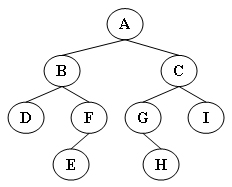函数接口定义:
void InorderTraversal( BinTree BT );
void PreorderTraversal( BinTree BT );
void PostorderTraversal( BinTree BT );
void LevelorderTraversal( BinTree BT );其中BinTree结构定义如下:
typedef struct TNode *Position;
typedef Position BinTree;
struct TNode{
ElementType Data;
BinTree Left;
BinTree Right;
};要求4个函数分别按照访问顺序打印出结点的内容,格式为一个空格跟着一个字符。
裁判测试程序样例:
#include <stdio.h>
#include <stdlib.h>
typedef char ElementType;
typedef struct TNode *Position;
typedef Position BinTree;
struct TNode{
ElementType Data;
BinTree Left;
BinTree Right;
};
BinTree CreatBinTree(); /* 实现细节忽略 */
void InorderTraversal( BinTree BT );
void PreorderTraversal( BinTree BT );
void PostorderTraversal( BinTree BT );
void LevelorderTraversal( BinTree BT );
int main()
{
BinTree BT = CreatBinTree();
printf("Inorder:"); InorderTraversal(BT); printf("
");
printf("Preorder:"); PreorderTraversal(BT); printf("
");
printf("Postorder:"); PostorderTraversal(BT); printf("
");
printf("Levelorder:"); LevelorderTraversal(BT); printf("
");
return 0;
}
/* 你的代码将被嵌在这里 */输出样例(对于图中给出的树):
Inorder: D B E F A G H C I
Preorder: A B D F E C G H I
Postorder: D E F B H G I C A
Levelorder: A B C D F G I E H思路:
二叉树的中,前,后,顺序遍历。
代码:
void LevelorderTraversal( BinTree BT )
{
if(BT == NULL)return;
struct TNode *queue[2000];
int head,tail;
head = tail = 0;
queue[tail++] = BT;
while(head!=tail)
{
printf(" %c",queue[head]->Data);
if(queue[head]->Left!=NULL)queue[tail++] = queue[head]->Left;
if(queue[head]->Right!=NULL)queue[tail++] = queue[head]->Right;
head++;
}
}
void InorderTraversal( BinTree BT )
{
if(BT == NULL)return ;
InorderTraversal(BT->Left);
printf(" %c",BT->Data);
InorderTraversal(BT->Right);
}
void PreorderTraversal( BinTree BT )
{
if(BT == NULL)return ;
printf(" %c",BT->Data);
PreorderTraversal(BT->Left);
PreorderTraversal(BT->Right);
}
void PostorderTraversal( BinTree BT )
{
if(BT == NULL)return ;
PostorderTraversal(BT->Left);
PostorderTraversal(BT->Right);
printf(" %c",BT->Data);
}
